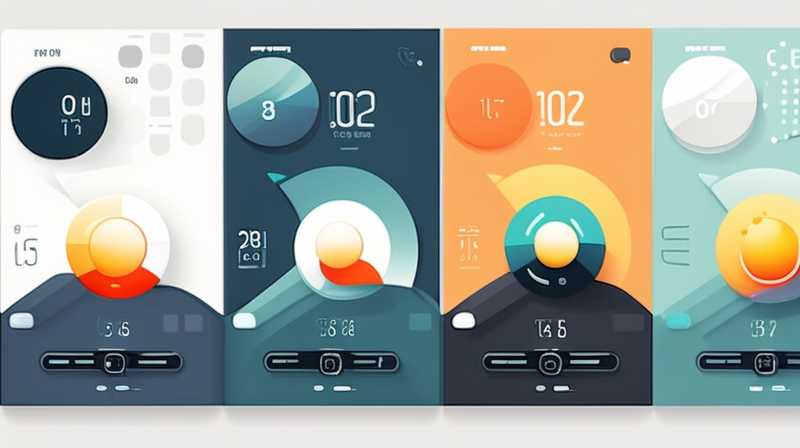
To effectively calibrate solar temperature, it requires a systematic approach that emphasizes precision and accuracy. 1. Understand the device specifications, 2. Employ a reference temperature sensor, 3. Perform calibration in controlled conditions, 4. Adjust the measurements accordingly. Calibrating a solar temperature sensor involves ensuring that the readings are accurate and reflect true solar irradiance conditions.
1. UNDERSTANDING DEVICE SPECIFICATIONS
When embarking on the journey of calibration, the initial step involves a comprehensive understanding of the specifications associated with the solar temperature sensor. Different devices come with various technical specifications, including their measurement range, resolution, and accuracy. Knowledge of these parameters is pivotal, as they inform the calibration process and highlight potential limitations within the instrument.
Consideration of the sensor type, whether it’s thermocouples, thermistors, or resistance temperature detectors (RTDs), plays a crucial role. Each sensor type operates under distinct principles and has unique calibration requirements. For instance, thermocouples might require consideration of cold junction compensation, while thermistors may necessitate a correction curve due to their non-linear response characteristics.
2. EMPLOYING A REFERENCE TEMPERATURE SENSOR
The calibration process necessitates utilizing a reference temperature sensor whose accuracy is undisputed. Calibration against a known standard is essential for verifying that the solar temperature readings are reliable. The reference sensor typically has a specified accuracy that exceeds that of the sensor being calibrated.
In a practical scenario, this involves placing both the sensor under calibration and the reference sensor in a closely controlled environment. By obtaining readings from both devices concurrently, discrepancies can be observed. It’s vital to document these readings meticulously to facilitate further analysis later in the calibration process.
3. PERFORMING CALIBRATION IN CONTROLLED CONDITIONS
Carrying out the calibration process in a controlled environment cannot be overstated. Environmental factors have a significant impact on sensor readings, which makes it crucial to minimize external influences during the calibration phase. Wind speed, humidity, and direct sunlight can alter temperature measurements, leading to inaccurate calibration.
To create an ideal calibration environment, utilizing a temperature-controlled chamber is recommended. In this setting, temperature can be precisely adjusted in increments, allowing scores of data points to be collected. Each reading should be logged carefully, allowing for a thorough analysis to identify any consistent deviations between the solar sensor and the reference sensor.
4. ADJUSTING THE MEASUREMENTS ACCORDINGLY
After gathering sufficient data during the calibration process, the next step involves adjusting the readings of the solar temperature sensor to align closely with the reference sensor’s data. This could include applying correction factors or adjustments based on a linear regression analysis of the data collected. The goal is achieving a close match between the two sets of measurements.
It is often helpful to develop a calibration curve based on the collected data. This method provides not only a means for correction but also an understanding of how the sensor behaves under various conditions. Dealing with outliers effectively and determining the systematic error ensures that accuracy is not compromised.
FAQs
WHAT IS THE IMPORTANCE OF CALIBRATING SOLAR TEMPERATURE SENSORS?
Calibrating solar temperature sensors ensures the accuracy and reliability of data obtained from solar energy systems. Precision is critical, particularly in renewable energy applications, where incorrect readings could lead to inefficiencies in energy extraction or system failure. Accurate temperature measurements allow for optimal performance monitoring and predictive maintenance, enabling engineers and operators to make informed decisions. When sensors are calibrated properly, they can reflect the true operational conditions, which helps in evaluating the effectiveness of solar panels and monitoring their energy output over time. Continuous calibration and adjustment may also be necessary to account for variations in manufacturing tolerances and environmental conditions, thus promoting long-term system reliability.
HOW OFTEN SHOULD SOLAR TEMPERATURE SENSORS BE CALIBRATED?
The frequency of calibration largely depends on the application, environment, and the specific sensor technology used. In critical applications or harsh environments, more frequent calibration may be necessary, whereas devices operating in stable conditions may require less frequent adjustments. Generally, a recommended practice is to perform calibration at least once a year or after significant weather events that could affect sensor performance. Enhanced monitoring techniques can also trigger recalibration alerts when readings deviate from expected norms, ensuring that the system maintains operational integrity. Ultimately, establishing a routine calibration schedule, backed by a calibration history and performance review, can greatly enhance the effectiveness of solar temperature sensors.
CAN ENVIRONMENTAL FACTORS AFFECT SOLAR TEMPERATURE MEASUREMENTS?
Absolutely, environmental factors can drastically influence solar temperature readings. Factors such as humidity, wind speed, and exposure to direct sunlight impose considerable variability on sensor performance. High humidity levels can lead to condensation on the sensor, resulting in erroneous readings, while strong winds can alter temperature measurements due to convective heat transfer. Furthermore, direct sunlight can cause overheating of the sensor, leading to inaccurate temperature readings. To minimize these impacts, it’s essential to position sensors in sheltered environments and utilize designs that mitigate these influences. Recognizing the interplay between environmental conditions and sensor performance is vital for ensuring the accuracy of temperature readings in solar applications.
Ensuring accurate calibration of solar temperature sensors is paramount in today’s renewable energy landscape. Precision in measurement influences the efficiency and effectiveness of solar energy systems. By methodically understanding device specifications, employing robust reference sensors, conducting calibrations in well-controlled conditions, and making necessary adjustments, professionals can uphold the integrity of their solar measurement systems. The importance of continuous calibration amidst ever-changing environmental factors cannot be overstressed, as it safeguards against inaccuracies that could compromise system performance. As the industry evolves, ongoing improvements in calibration techniques and sensor technologies will play a significant role in advancing solar energy utilization. Proper calibration enables energy professionals to move confidently towards achieving their goals, significantly impacting both performance metrics and overall operational effectiveness.
Original article by NenPower, If reposted, please credit the source: https://nenpower.com/blog/how-to-calibrate-solar-temperature/


